Once the reporter of the city's dark lanes, author Ajith Pillai's new book captures the growth of parochialism of all shades


Shuklaji Street in Kamathipura is one of the places that takes centre stage in Ajith Pillai’s Junkland Journeys, which takes us through the Mumbai of the eighties
 Sit back and imagine yourself solving a crossword puzzle on a weekday afternoon at Colaba’s Goks bar. A hundred rupee note will be enough for beer, fish curry and rice; waiters can be instructed not to rush the servings. After lunch, you walk across to the Gateway of India and gaze at the ships coming into the harbour. If you want to catch a few winks, matinee shows in Regal or Strand offer perfect spots. No text message will vitiate your peace; no ringtones to remind you of an imminent appointment.
Sit back and imagine yourself solving a crossword puzzle on a weekday afternoon at Colaba’s Goks bar. A hundred rupee note will be enough for beer, fish curry and rice; waiters can be instructed not to rush the servings. After lunch, you walk across to the Gateway of India and gaze at the ships coming into the harbour. If you want to catch a few winks, matinee shows in Regal or Strand offer perfect spots. No text message will vitiate your peace; no ringtones to remind you of an imminent appointment.
ADVERTISEMENT
Delhi-based writer Ajith Pillai’s debut novel Junkland Journeys — published by Authors Upfront — has a feel of the leisurely afternoon in the Mumbai of the eighties, where action (or the lack of it) takes place at Shuklaji Street in Kamathipura, Sunshine Country Bar in Mahim and the dingy flats of CGS Colony at Antop Hill. Pillai catches the city at a time when it was not a swanky megapolis with multiplexes and malls; smartphone gadgetry did not govern every lived moment; and Topaz Chitrahaar song clips epitomised television entertainment. In a low-tech pre-Internet space, Pillai’s hero (Hari Menon) finds life in the bylanes of Colaba and Ballard estate. Menon’s journey of self-discovery takes him places — Kavil (Kerala) to Lonavala and then to Lucknow. But, the soul of Pillai’s book is firmly placed in a pre-globalised Mumbai, a city which, he says, now exists only in people’s memories.
Pillai, 58, is ferociously fond of a specific period in Mumbai (eighties and early nineties up to the 1993 serial blasts), before which he was based in Kochi as an ad copyrighter. As per his world view, the 1992 communal riots robbed the maximum city of its old world charm and it was also a defining point for the escalation of communalism and regionalism. He is convinced that his protagonist, a recovering drug addict, couldn’t have existed in any other milieu than the one provided by a city on the cusp of change. Menon, a confused young man from the upper echelon, takes to Idukki Grass because he believes that dope expands the mind and reveals a perspective unknown to a non-smoker.
He leaves a respectable advertising agency job and his parents to rent a pokey flat in Antop Hill, only to be surrounded by some who are waiting for a work permit to the Middle east; and some deliberately living below their means (slumming) in a fit of revolt against their capitalist parents. Pillai feels younger people now “can’t drop out of life and claw back,” also that the old Bombay gave people second and third chances. His views are, of course, to be assessed on a relative scale because successive generations have found Mumbai kinder during their times.
Pillai, now an independent writer, worked for The Sunday Observer (now defunct) in the mid-80s, and the current work of fiction draws sustenance from the intriguing people he met, mostly heroin/brown sugar addicts, pushers selling the dope, parents and rehabilitation professionals. In fact, he had gained a reputation as a Low Life correspondent covering the red-light areas, especially after journalist Dhiren Bhagat called him by that name in the Spectator magazine. Pillai conducted guided tours for fellow journalists in the addas where druggies gathered around the pusher-man. He has also taken author V S Naipaul to one such spot in Dadar (early 1989) which figures in Naipaul’s ‘A Hundred Mutinies Now.’
The drug stories took Pillai in several directions — including Dr Yusuf Merchant’s Drug Abuse Information Rehabilitation Centre on Palton Road near Crawford Market, where he served as a volunteer-counsellor of sorts for a while. A chance meeting with a recovering addict from a wealthy business family proved educational. Pillai never reported the story or alluded to it, as, by then, “such stories had become passe with editors who were no longer interested in the travails of drug addicts.” The ‘rich kid misunderstood by parents and lured to drugs’ stories were cliched for the reader, too, says Pillai. But, 24 years later — sometime in 2007 — the addict tracked down Pillai. He was now a transformed swami in saffron robes — a guru with small ashrams in Canada, Australia and a few other places in europe. His trajectory became the basis of Junkland Journeys, just as Pillai’s earlier book, Off the Record, was a reporter’s diary, a compilation of the untold stories behind the stories — an insider’s view of journalism. His next anthology of short stories is set in the India of the future; also a book on Indian Rock in which Mumbai of today and yesteryear will figure.
Junkland Journeys needs to be taken note of — not just for the social documentation of Mumbai — but because it traces the growth of parochialism of all shades. Pillai has been unsparing in baring the insularity and conceit that Indians harbour for each other, knowingly and unknowingly — a Kutty declaring everything about Kerala as the best in the world, Rajan Mishra ridiculed as a ‘Bihari’ by his Tamilian in-laws; Chandrakant Borde and Avinash Mane being killed for not ‘looking’ Hindu and Marathi ‘enough’ during the riots. Prejudice comes naturally to a society divided by class, caste and religion.
Pillai’s book underlines India’s high gullibility rate in the matters of religious faith. His hero thrives as a God-Dog Man who communicates to the world through a dog with divine powers. The dog idea brings home the clever networking with which a religious cult can take root in Maharashtra or anywhere in India. People seek spiritual masters because gurus double up as counsellors. Pillai empathises with those who need psychological help without being seen as needy. Today’s Mumbai has no dearth of cults that provide succour, but without being seen as rehabilitators. Pillai goes back in time to show a juncture where the mental wellness industry joined hands with the spiritual establishments.
Sumedha Raikar-Mhatre is a culture columnist in search of the sub-text. You can reach her at sumedha.raikar@gmail.com
 Subscribe today by clicking the link and stay updated with the latest news!" Click here!
Subscribe today by clicking the link and stay updated with the latest news!" Click here!







